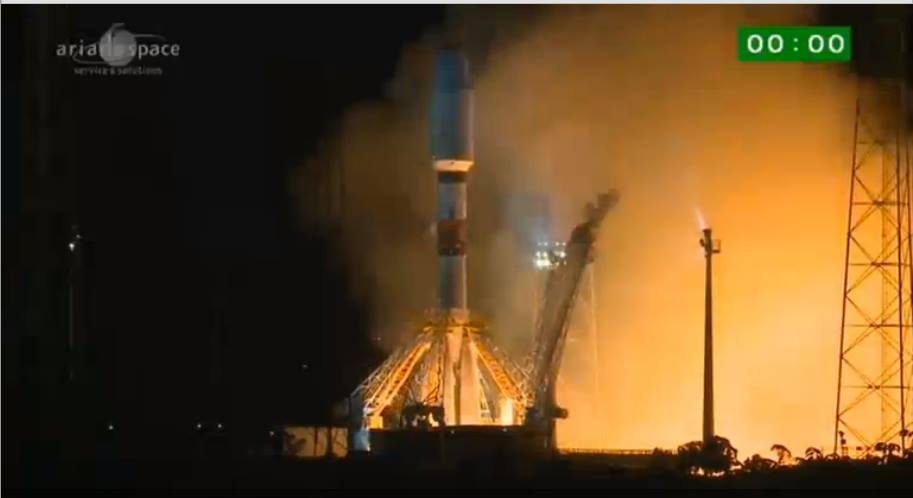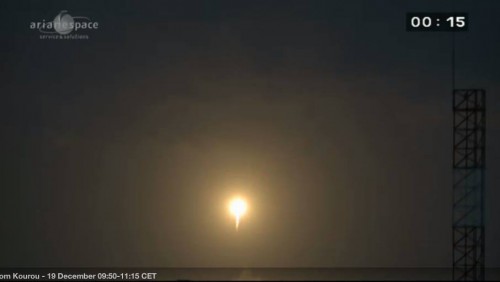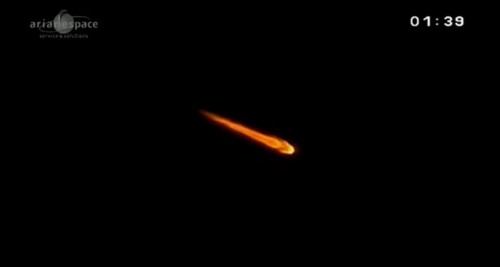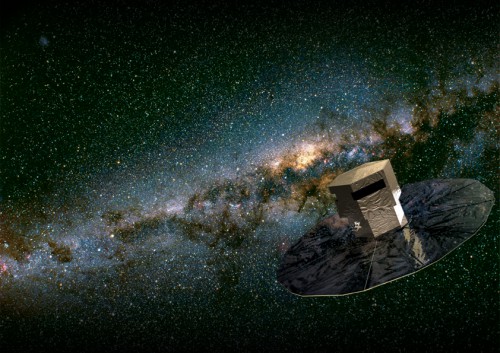
Yesterday’s successful launch of the ambitious Gaia mission for the European Space Agency (ESA) has set another spacecraft en-route for the Earth-Sun L2 Lagrangian Point, a position about 930,000 miles (1.5 million km) beyond the Home Planet, at which the gravitational influences of both celestial bodies meet in balance. Delayed since October, the long-awaited mission is expected to arrive at its distant location—also occupied by ESA’s now-defunct Herschel observatory and the recently deactivated Planck space telescope—in about three weeks’ time. The location will enable it to enjoy a very stable thermal environment for its 5.5-year astronomical survey.
Thursday’s launch of Gaia from the Guiana Space Centre in Kourou, French Guiana, proceeded like clockwork, with the Soyuz ST-B booster and its Fregat-FT upper stage confirmed as fully fueled at 5:12 a.m. French Guiana Time (3:12 a.m. EST), an hour ahead of liftoff. The mobile gantry was retracted to a distance of about 330 feet (100 meters) from the pad, exposing the vehicle to the elements. Similar in design to the Soyuz vehicles which, four times yearly, rocket crews of astronauts and cosmonauts toward the International Space Station (ISS), this vehicle comprised three main stages. Its central core, fed by a single RD-108A engine, was surrounded by four tapering boosters, themselves powered by RD-107A engines. All were fueled with a mixture of liquid oxygen and a refined form of rocket-grade kerosene, known as “RP-1.”
The second stage was connected to its lower counterpart by a lattice-like framework, and its single RD-0110 engine was timed to ignite a couple of seconds after the separation of the first stage. Finally, the Fregat upper stage—capable of restarting up to 20 times in flight, but planned for just two discrete “burns” on this mission—was powered by the storable propellants unsymmetrical dimethyl hydrazine and nitrogen tetroxide. Its inclusion in the vehicle allows the Soyuz to deliver payloads to a range of orbits, from low, medium, and geostationary altitudes and onto Earth-escape trajectories.

Five minutes before liftoff, at 6:07 a.m. GFT (4:07 a.m. EST), the Launch Key—a physical key needed to transfer control to the Soyuz systems, activate ground and vehicle telemetry, and allow the final stages of the countdown to proceed—was inserted. Nitrogen purging to remove contaminants from fuel lines and engine combustion chambers followed, and at 6:09 a.m. GFT (4:09 a.m. EST), as planned, umbilical connectors were severed between Gaia and the ground control system. All fuel tanks were confirmed at flight pressure, and the final topping-off of cryogenic propellants was terminated shortly afterward. Sixty seconds later, the Soyuz transitioned to internal power and the autosequence got underway, controlling all vehicle critical functions through liftoff. First stage ignition got underway at 6:11:59 a.m. GFT (4:11:59 a.m. EST), and after final umbilical disconnections and confirmation that all turbopumps were operating at full speed and all engines at full power, the vehicle lifted off precisely on time at 6:12:19 a.m. GFT (4:12:19 a.m. EST).
In the seconds after leaving the pad, the vehicle executed a combined pitch, roll, and yaw maneuver to establish itself onto the proper flight azimuth for the injection of Gaia into space. Rising rapidly, it passed 1,100 mph (1,770 km/h) within a minute of liftoff. At T+118 seconds, at an altitude of about 28 miles (45 km), the four tapering boosters exhausted their propellant and were jettisoned, leaving the central core and its single engine to continue the ascent. By two minutes into the flight, the vehicle was traveling at over 3,350 mph (5,390 km/h). The payload fairing was jettisoned shortly afterward, and, some five minutes after leaving Kourou, the core separated at an altitude of 105 miles (170 km) and the third and final stage ignited to boost the vehicle to a velocity in excess of 13,420 mph (21,600 km/h). By the time the third stage departed the vehicle, nine minutes into the flight, Gaia was in space and ready for the two planned “burns” by the Fregat upper stage. The first burn, lasting just over two minutes, began at 6:22 a.m. GFT (4:22 a.m. EST) and lifted the payload into an intermediate orbit, preparatory for the final push toward Earth-escape orbit.

A second burn commenced at 6:33 a.m. GFT (4:33 a.m. EST) and ran for almost 16 minutes to place Gaia onto the escape trajectory, which will see it delivered to a “Lissajous” orbit around the Earth-Sun L2 Lagrangian Point, a position about 930,000 miles (1.5 million km) beyond the Home Planet, at which the gravitational influences of both celestial bodies meet in balance. After the conclusion of the second burn, the Gaia/Fregat combo coasted for five minutes, ahead of the separation of the payload at 6:54:18 a.m. GFT (4:54:18 a.m. EST). The final act of the Fregat was to execute one final collision-avoidance maneuver to establish it into a so-called “graveyard orbit.”
Delayed since October, Gaia is a $1.2 billion mission to observe a billion astronomical objects—equating to about 1 percent of the Milky Way—over 5.5 years. As part of ESA’s Horizon 2000 Plus program, it will continue the astronomical parallax work undertaken by the 1989-launched Hipparcos mission and will analyze each of its target stars no fewer than 70 times. Gaia’s observations will lead to the creation of precise three-dimensional maps of star motions, yielding detailed physical properties, characterizing luminosities, pegging effective temperatures, and compiling databases of gravitational and elemental compositions. In addition to stars and galaxies, half a million quasars will fall under Gaia’s gaze, together with around 1,000 extrasolar planets and objects within our Solar System, including mysterious “Apohele” asteroids which lurk between Earth and the Sun.

Of its stellar targets, the distances of about 20 million stars will be measured with an accuracy of approximately 1 percent and another 200 million will be measured with an accuracy of 10 percent. Orbiting the L2 Lagrangian Point—which was also occupied by ESA’s now-defunct Herschel observatory and the recently deactivated Planck space telescope—Gaia will enjoy a very stable thermal environment. Its 35-foot (10-meter) sunshade will be deployed to always face the Sun, thereby cooling its sensitive instruments.
Originally conceived in the early 1990s, following the success of Hipparcos, the Gaia mission steadily progressed through various levels of ESA, gaining Science Programme Committee approval in October 2000 and entering the hardware construction phase—with EADS Astrium as its prime contractor—in February 2006. Its payload includes an astrometry instrument to precisely determine the positions, distances, and proper motions of stellar objects, a photometric instrument to gather spectral data, and a radial-velocity spectrometer to determine the velocity of objects. Fine-pointing of the Gaia spacecraft is achieved partly through its virtual absence of moving parts and its rigid silicon-carbon framework, which will neither expand or contract due to temperature variations in space.
Want to keep up-to-date with all things space? Be sure to “Like” AmericaSpace on Facebook and follow us on Twitter: @AmericaSpace
Missions » GAIA »


